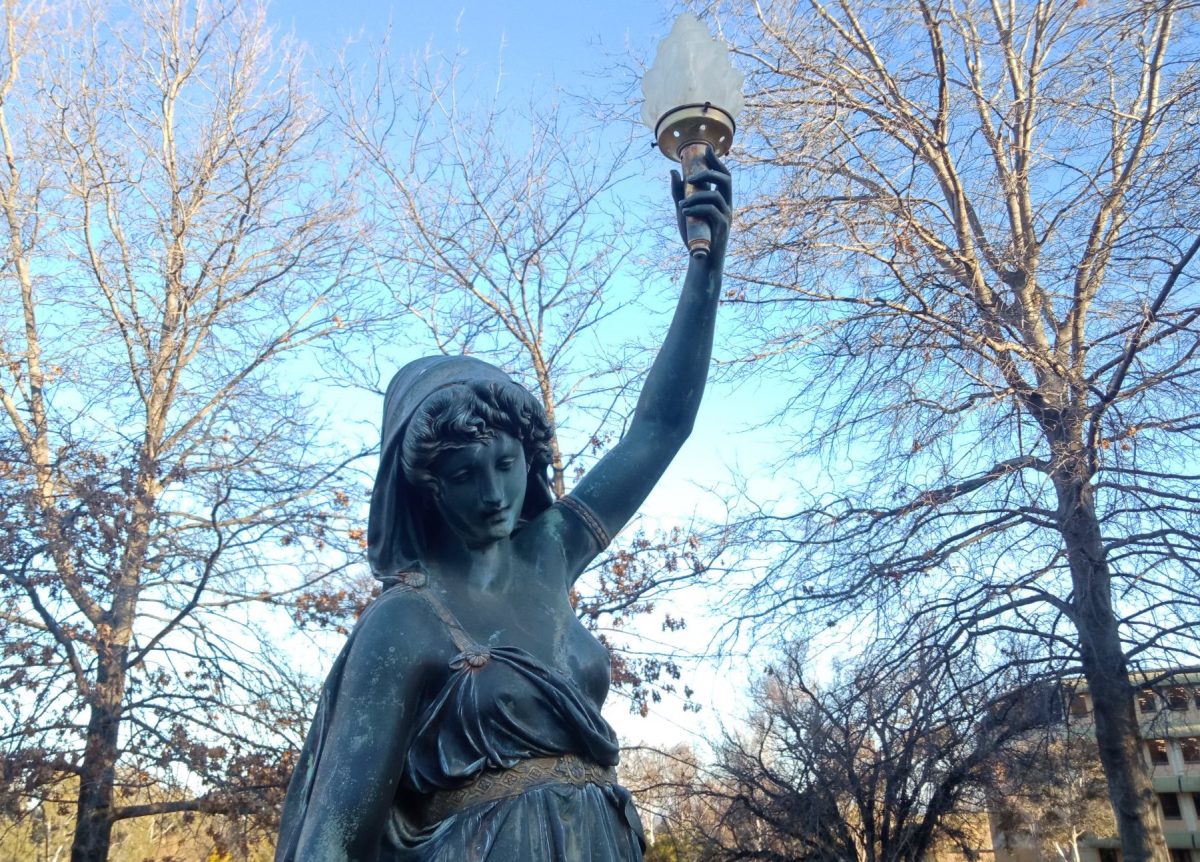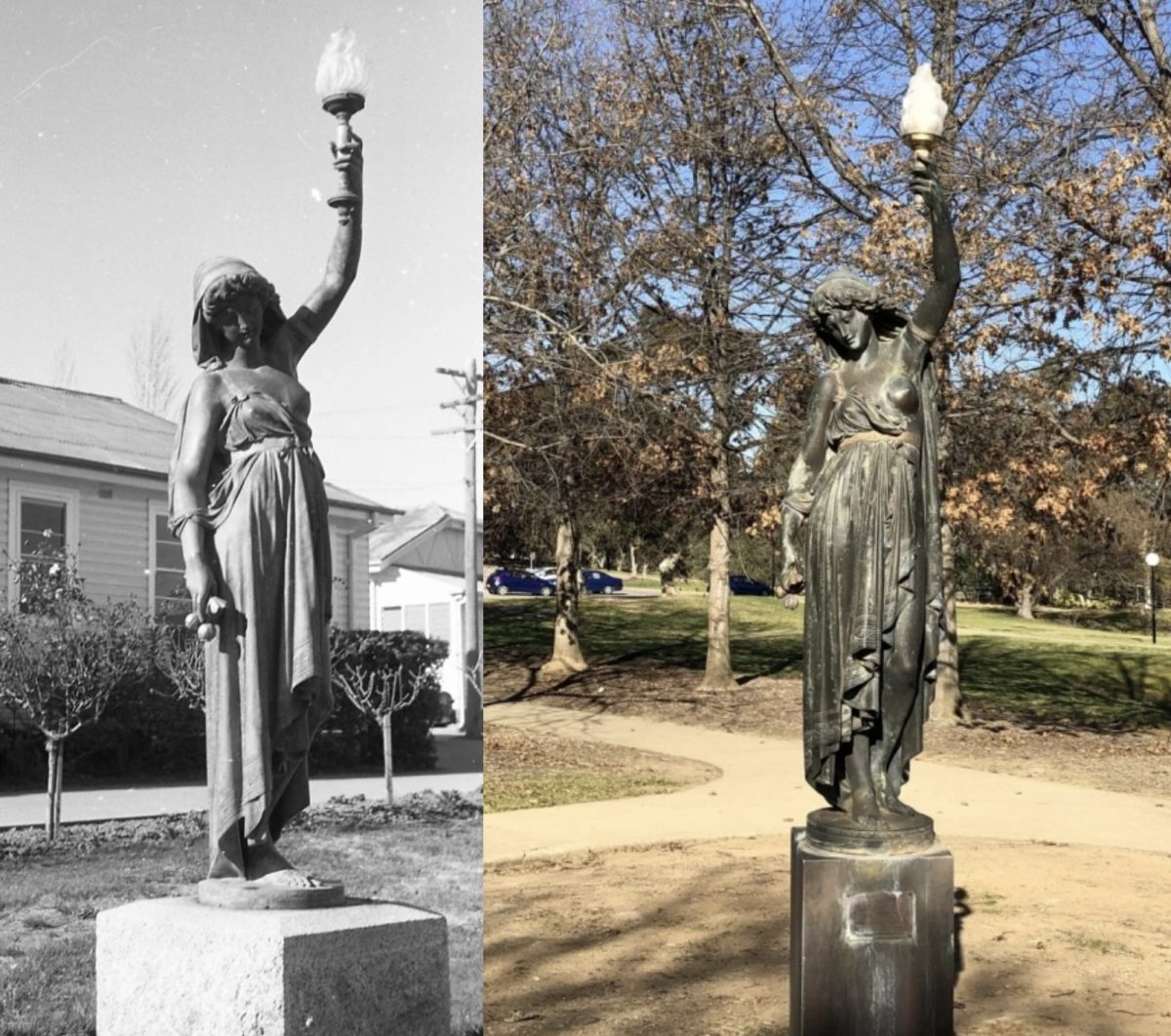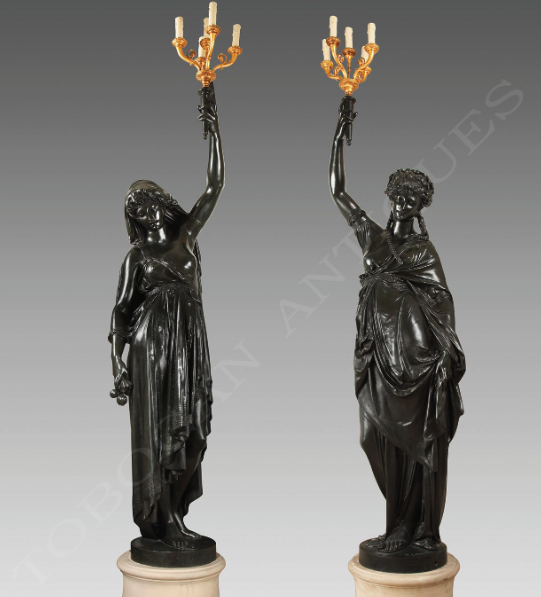
Mrytle has found a home on CSU’s Tabbita Walk. Photo: Jan Pittard.
On Tabbita Walk on Charles Sturt University’s south campus, close to a student accommodation block and a set of colour-coded wheelie bins, is an approximately half-life-sized classical bronze statue of a woman in robes. One breast bared, she holds aloft a torch in her left hand and clutches a plant sprig in her right.
She is perched on a metal plinth eroded at one corner by dog pee and displaying a plaque that reads, “Myrtle – Carrier–Belleuse, France – Donated to Wagga Wagga Teachers’ College by the Wagga Wagga Chamber of Commerce in 1954”.
Wagga Wagga Teachers’ College operated from 1947 to 1971 on the site of a former RAAF hospital in Turvey Park and Myrtle once graced the lawn in front of the principal’s office next to a large crepe myrtle bush – hence her name.
Perhaps unsurprisingly, given her semi-nudity, Myrtle attracted the attention of students who caressed her bared breast so diligently that it shone.
In 1961 the December edition of the college newsletter published a tongue-in-cheek “expense account of the average male student” which included a monthly donation to the “Myrtle Steel Wool Fund”, reportedly to assist in burnishing the exposed breast.

The December 1961 edition of Talkabout mentions the Myrtle “Steel Wool Fund” to keep her breast burnished. Photo: CSURA.
When Myrtle’s plinth was one day found vacant, it was believed that principal Maurice Hale had ordered the statue’s removal. Opinion was divided on whether it was due to concern for the statue’s patina or to avoid being flashed by the glaring sun reflecting off her polished bosom and shining into his office.
The grief over her disappearance was widespread and students reacted by decorating her abandoned plinth with flowers and inscribing it ‘In Memory of Myrtle’.
Where Myrtle was stored after her removal is unclear but at some point, her artistic and historical value were recognised and she found a new home on Tabbita Walk.
So, who was Myrtle and how did she come to find a home at the Wagga Wagga Teachers’ College in 1954?

Myrtle then and now. Photo: CSU Regional Archives.
Albert-Ernest Carrier-Belleuse was an acclaimed 19th-century French sculptor. The National Gallery of Australia calls his style ‘voluptuous antiquity’, an apt description of Myrtle with her classical garb, sinuous lines and semi-nudity.
Carrier-Belleuse had a highly successful career in France and Britain producing major works usually featuring allegorical or mythological subjects.
His designs adorned many public buildings in Europe and the UK and today you can see his works in the Metropolitan Museum of Modern Art in the US, the San Martín Cathedral in Buenos Aires and in Australia’s own National Gallery.
The sculpture likely dates from the 1850s meaning she may have already been over 100 years old when she arrived in Wagga.
According to a story in The Daily Advertiser on 29 April 1954, Myrtle was not initially a “gift” as the inscription suggests.
“The Wagga Teachers’ College were granted a £25 donation and an interest free loan of £75 to cover the cost and erection of bronze statuary outside the college. The statuary is by well-known Australian (sic) sculptor A. Carrier. The college plans to illuminate the statue and install a plaque at the base.”
The reporter was mistaken about the sculptor’s nationality – did they also get the purchase arrangements wrong? Or did the Chamber of Commerce waive the debt later?
Either way, the bare-breasted Myrtle joined an impressive art collection at the college but was at odds with the modernist flavour of most other pieces.

The full set! A.E. Carrier-Belleuse pair of torchieres “Night” and “Day”. Photo: Tobogan Antiques.
CSU’s Art Curator, Dr Tom Middlemost, and archivist Jillian Kohlhagen, have provided some answers to the mystery surrounding Myrtle’s origins.
She is one of a pair of bronze ‘torchiere-holders’ (torch holders), designed to support gilded candelabra.
The figures represent Night and Day. Myrtle, whose head is draped and who holds sleep-inducing poppies in her right hand, is Night.










